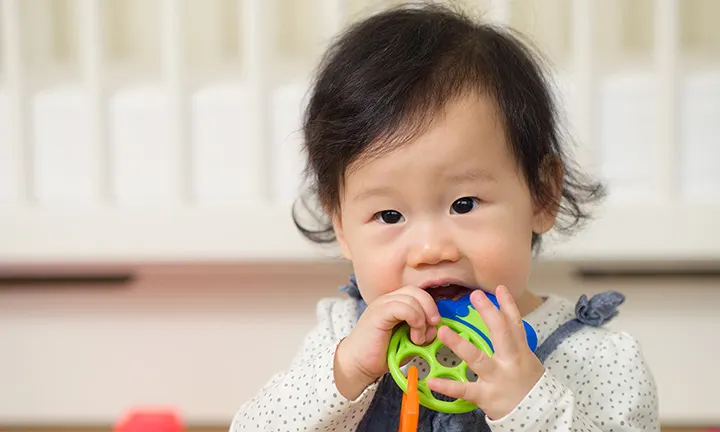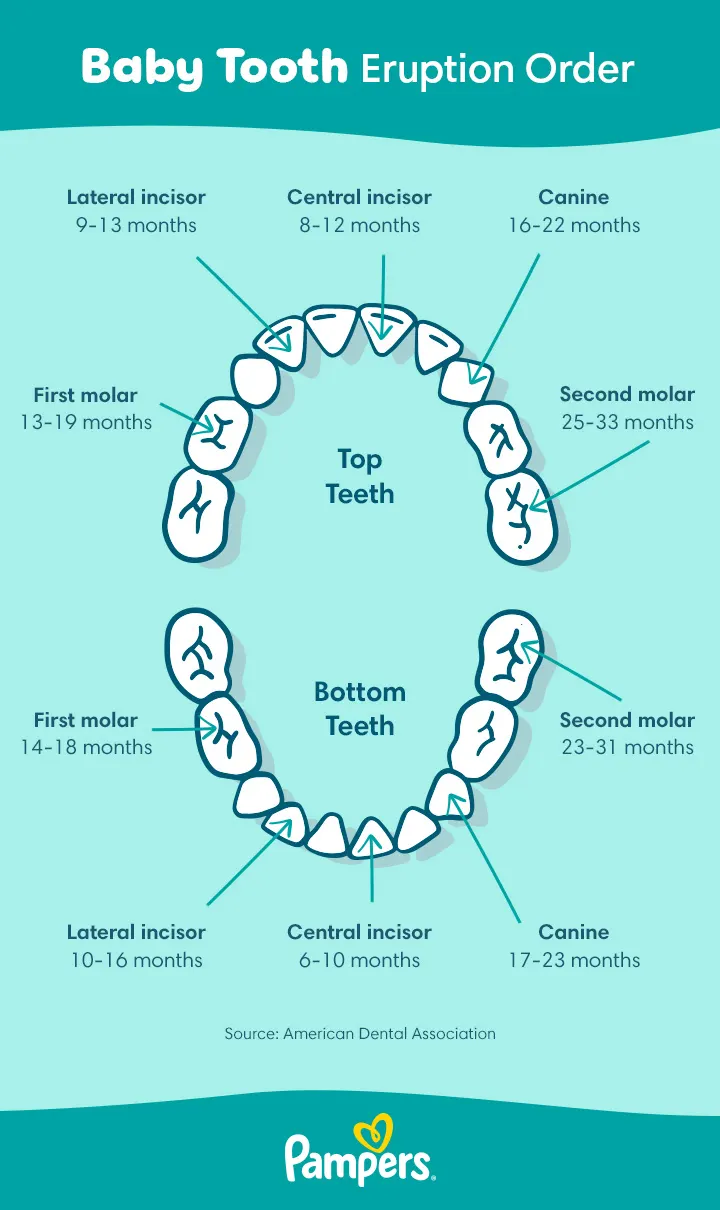When Do Babies Start Teething? Signs, Timeline, & Care Tips
Teething is an exciting milestone that marks the arrival of your baby’s first teeth. If you’re wondering, "When do babies start teething? ” the answer varies—every baby follows their own timeline. Most infants begin teething between 4 and 7 months, though it can kick off as early as 3 months or as late as a year. The first to emerge are usually the bottom front teeth (lower central incisors), followed by the top front teeth. But remember, every baby is unique, and timelines can vary greatly.
In this article, we’ll explore how to soothe teething discomfort and what to expect as those tiny teeth come in.
How Long Does Teething Last? Understanding the Stages
If you’re wondering, "How long does teething last? " the full process typically stretches over about two years. Most babies will have their full set of 20 primary teeth sometime between their second and third birthdays.
But how long does teething pain last during that time? The discomfort usually comes and goes. Many babies feel sore for a few days before each new tooth breaks through. Then things tend to settle—until the next one starts to come in.
Signs and Symptoms of Teething: What to Expect
Teething can look different for every baby. Sometimes a tooth appears with little to no warning. Other times, signs of teething may start 3 or 4 days before a tooth pushes through the gumline.
Not sure how to tell if an infant is teething?Here are some of the most common baby teething symptoms to look for:
Irritability. A bit more fussiness or crying than usual may be a clue that your little one is uncomfortable.
Disturbed sleep. Teething discomfort can make it harder for babies to settle or stay asleep at night.
Increased drooling. Extra saliva is a classic sign that your baby is teething. It may even help soothe their gums.
Chewing on things. You might notice your little one gnawing on toys, hands, or a teething ring. This helps relieve the pressure from their baby's gums when teething.
Sore, swollen gums. The area where a tooth is coming in may look red or puffy—one of the clearest signs of teething in infants.
Low-grade temperature. Mild warmth may occur, but teething is unlikely to cause a fever over 101°F. If your baby is under 3 months and has a temperature of 100. 4°F or higher, or if you’re concerned at any point, consult your little one’s healthcare provider.
What’s Normal and What’s Not During Teething
Most babies experience teething symptoms like mild irritability, gum swelling, drooling, and a slight temperature rise. But it’s helpful to know which symptoms may not be caused by teething and could signal something else.
Here’s how to tell the difference:
Does teething cause fever? A mild temperature increase, typically under 100. 4°F (38°C), can occur. But a high fever is not caused by teething and may point to an illness.
Can teething cause diarrhea or a runny nose? While these often show up around the same time as teething, they aren’t caused by it. Diarrhea or nasal congestion is more likely from a viral infection.
Can teething cause vomiting or appetite loss? No, vomiting is not a normal teething symptom. If your little one shows signs of stomach upset or a major change in eating, speak with your baby’s healthcare provider.
Can a face rash occur when teething? A teething rash around the mouth or chin can be caused by drooling. But a widespread or severe rash may be something else, like an allergy or skin irritation.
If your baby has a fever, vomiting, diarrhea, or any unusual or intense symptoms, check in with your baby’s healthcare provider to rule out other causes.
Teething Timeline: From First Tooth to Full Smile
When each tooth comes in and in what order varies from child to child, but here’s a general idea of the teething timeline by age:
Top Teeth
Central incisors (the front teeth): 8 to 12 months
Lateral incisors (the teeth on either side of the front teeth): 9 to 13 months
Canines, or cuspids (the sharp, pointy teeth on either side of the lateral incisors): 16 to 22 months
First molars (the back teeth used to grind food): 13 to 19 months
Second molars (the back teeth that fill in the last gaps): 25 to 33 months
Bottom Teeth
Central incisors (the front teeth): 6 to 10 months
Lateral incisors (the teeth on either side of the front teeth): 10 to 16 months
Canines, or cuspids (the sharp, pointy teeth on either side of the lateral incisors): 17 to 23 months
First molars (the back teeth used to grind food): 14 to 18 months
Second molars (the back teeth that fill in the last gaps): 23 to 31 months.
How to Soothe a Teething Baby: Proven Remedies
Teething can be uncomfortable, especially at night, but there are simple ways you can offer some relief to a teething baby. Every child is different, so you may need to try a few options to see what helps most.
Here are two gentle teething remedies that many parents find helpful:
Massage the gums. For natural gum pain relief, try gently rubbing your baby’s gums with a clean finger. It’s a quick, soothing option and one of the most effective home remedies for sore gums.
Offer something safe to chew on. Chewing helps relieve pressure. You can chill certain safe items in the fridge, not the freezer, to give your little one a cooling relief. (We’ll talk more about teething toys next.)
Avoid using pain relievers that you rub on your babies’ gums. They aren’t very helpful and can cause numbing of the back of the throat, which can result in swallowing problems. If your baby is clearly uncomfortable, talk to your healthcare provider about giving a weight-appropriate dose of acetaminophen, or, if your baby is older than 6 months, ibuprofen.
These tips may also serve as home remedies for teething baby at night, when discomfort tends to interrupt sleep. If you're not sure how to help teething baby or your little one seems especially unsettled, your baby’s healthcare provider can help guide you.
Best Teething Toys for Babies
When your baby is teething, having something safe to chew on can make a big difference. Teething toys help apply gentle pressure to the gums, which can ease discomfort and offer a welcome distraction.
One common option is a teething ring, which many babies find soothing, especially when it’s chilled in the fridge for extra relief. Just make sure it’s not frozen solid, which could be too harsh for your little one’s sensitive mouth.
The best teething toys for babies are easy to grip, made from baby-safe materials, and designed specifically for soothing sore gums. Silicone or rubber textures tend to be favourites, and some are shaped to reach the back of the mouth as molars start to come in.
Always check the label to ensure the toy is age-appropriate and supervise your baby during teething play.
Caring for Your Baby’s New Teeth: Essential Tips
It’s important to start caring for your baby’s teeth (or tooth) as soon as the first one pokes through. Those milk teeth must last several years before they’re replaced with adult teeth, and establishing good dental hygiene habits early on will help set your little one up for healthy teeth and gums throughout their life.
Brushing Your Baby’s Teeth
Wondering when to start brushing baby teeth? Start as soon as the first tooth comes in. Regular brushing—twice a day—is key for keeping baby teeth clean and healthy.
Tips for brushing your baby’s teeth:
Brush twice a day, especially after sugary foods or drinks, and before bed.
Use a soft-bristled toothbrush and a tiny smear of fluoride toothpaste. Around age 2 or 3, you can switch to a pea-sized amount.
Focus on brushing each tooth from all angles, including the back and sides.
For now, you’ll need to brush your baby’s teeth. As they reach the toddler and preschool stage, help them begin to brush their teeth under your close supervision. You'll need to lend a hand until they’re 7 or 8 years old to ensure those teeth get thoroughly cleaned. Here are some ideas for how to make brushing more fun for both of you.
When to See Your Baby’s Healthcare Provider
If your little one has symptoms like fever, diarrhea, or unusual irritability, and you’re unsure if it’s related to teething or something else, it’s best to check in with your baby’s healthcare provider. They can offer a proper diagnosis and ensure nothing more serious is going on.
You should also reach out if your little one seems to be in significant discomfort from teething. The provider may suggest safe ways to manage pain, but avoid numbing teething gels, which may be harmful to infants.
Finally, contact your baby’s provider or dentist if your child has a tooth injury , like a chipped or broken tooth. It’s always safer to have it checked, even if your baby seems unbothered.
Interesting Facts About Baby Teeth You Didn’t Know
Looking for some surprising baby facts about those tiny teeth?Here are a few things you may not know about milk teeth and the teething process:
On average, about 4 teeth erupt every 6 months during early childhood.
Sometimes a baby is born with teeth—called natal teeth—though this is rare and usually involves just one or two early arrivals.
Girls’ teeth may come in a bit earlier than boys’ teeth.
Bottom teeth typically emerge before the same ones on top.
Teeth usually erupt in symmetrical pairs—one on each side of the jaw around the same time.
Milk teeth (also known as primary teeth) are smaller and whiter than the adult teeth that follow.
Around age 4, your child’s face and jaw will begin to grow, creating space between teeth—this is normal and makes room for permanent teeth.
How many teeth do babies have? A full set includes 20 milk teeth, but your child will eventually have 28 to 32 adult teeth by their teens or early twenties.
FAQS AT A GLANCE
Signs may include fussiness, disrupted sleep, swollen or tender gums, lots of drooling, and a strong urge to chew on fingers or toys. These teething symptoms often show up a few days before a tooth breaks through the gumline.
The Bottom Line
Teething can be a tough phase—for your little one and you—but it’s also a meaningful milestone. Those little teeth will soon help your child bite into new foods and support their speech and development.
If that first tooth hasn’t shown up yet, hang in there—it’s likely just around the corner. Each new arrival brings your baby one step closer to a full, confident smile.
Caring for those tiny milk teeth now sets the stage for a lifetime of healthy habits. Before you know it, your little one’s grin will be full of some of the cutest, brightest teeth you’ve ever seen.
Don’t forget to check out the Pampers Club app —it’s a great way to earn rewards and unlock digital offers just by purchasing diapers and wipes.
How We Wrote This Article The information in this article is based on expert advice found in trusted medical and government sources, such as the American Academy of Pediatrics and the American College of Obstetricians and Gynecologists. You can find a full list of sources used for this article below. The content on this page should not replace professional medical advice. Always consult medical professionals for a full diagnosis and treatment.
Join Pampers Club and get:





